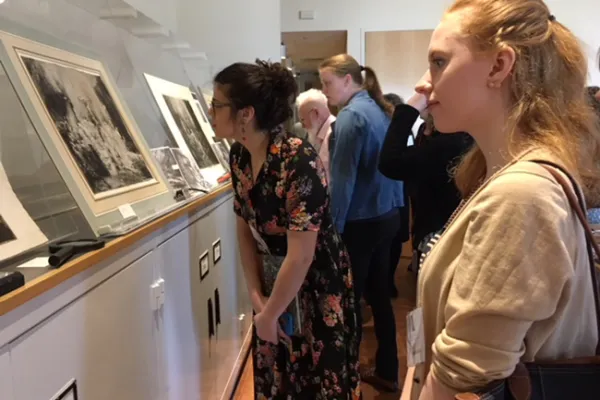Art Up Close: SCMA Hosts Rembrandt Study Day
Smith Arts

Published April 20, 2018
How can you tell if a Rembrandt print is real?
The material it’s printed on is an important clue: 17th-century paper has specific characteristics and marks that distinguish it from modern papers. Rembrandt liked to print on thin papers and parchment.
That was just one of the scholarly insights shared last week at a Rembrandt Study Day at the Smith College Museum of Art. The April 14 session brought experts together with students and faculty for some “close looking” at three versions of The Three Crosses, a rare Rembrandt print donated to the museum in late 2017 by Mary Gordon Roberts ’60.
These works are a wonderful way into the world of prints.
Following the study session, the SCMA’s Cunningham Center for the Study of Prints, Drawings and Photographs was opened to the public, and about 50 people stopped in to view the prints and talk with museum curators.
“I have never been asked so many questions,” said Henriette Kets de Vries, an assistant curator at SCMA and manager of the Cunningham Center. “I had some really great, long discussions with people—young and old. These works are a wonderful way into the world of prints.”
For Maddy Greaves ’18—one of two Smith students invited to the morning study session—the event was a rare chance to explore the process of producing a powerful work of art.
“People often forget the importance of materials and how that influences the composition,” said Greaves, who is majoring in art history. “As an undergraduate, to have this opportunity was really amazing!”
Amanda Bolin ’18, also appreciated the “hands-on” nature of the study session, where participants got to handle engraving tools and paper samples, as well as share their thoughts about the different versions—or “states”—of Rembrandt’s print.
“I liked seeing the tools,” said Bolin, who is majoring in art history and medieval studies. “I’m working in the Cunningham Center right now, and I’m getting more interested in the printmaking process. It was exciting to be able to do this up-close in-depth analysis.”
Participants were given their own tools for the study session: small flashlights and magnifying glasses to help them peer at the fine lines and changing figures in Rembrandt’s depiction of Jesus on the cross and of the two thieves who were crucified with him.
Led by Theresa Fairbanks-Harris, senior paper conservator at Yale University, and Margaret D. Carroll, professor of art at Wellesley College, the session gave participants a chance to debate the merits of engraving vs. etching, track how images evolved in different states of the print, and speculate about other aspects of the Dutch artist’s process. (Among the topics discussed: Did Rembrandt produce all of those prints himself, or did he have assistants? How did his composition take on new meaning with each reworking?)
Barry Moser, Smith’s Irwin and Pauline Alper Glass Professor of Art, said he was pleased that the session raised as many questions as answers about Rembrandt’s work.
“I liked that there were times when the scholars simply said, ‘We don’t know,’” he noted. “It’s good to retain some mystery.”
(The Rembrandt prints are not currently on view at the SCMA, but they can be seen by appointment in the Cunningham Center during museum hours. To schedule a viewing, email hketsdev@smith.edu. )
Maddy Greaves'18 (left) and Amanda Bolin '18 do some close looking at three rare Rembrandt prints during a study session at the Smith College Museum of Art.